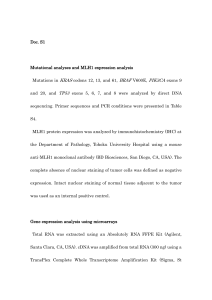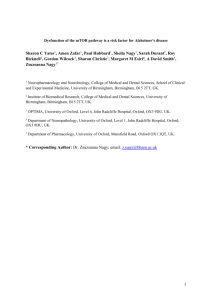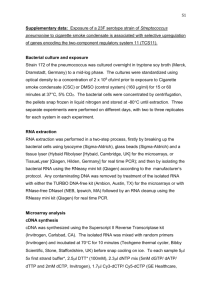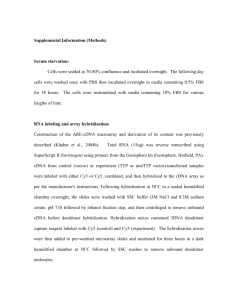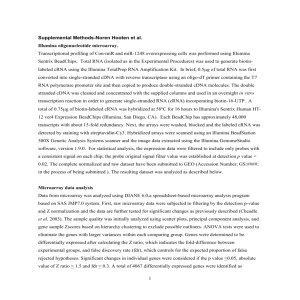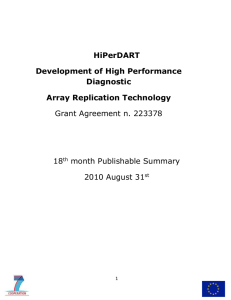Materials and Methods
advertisement
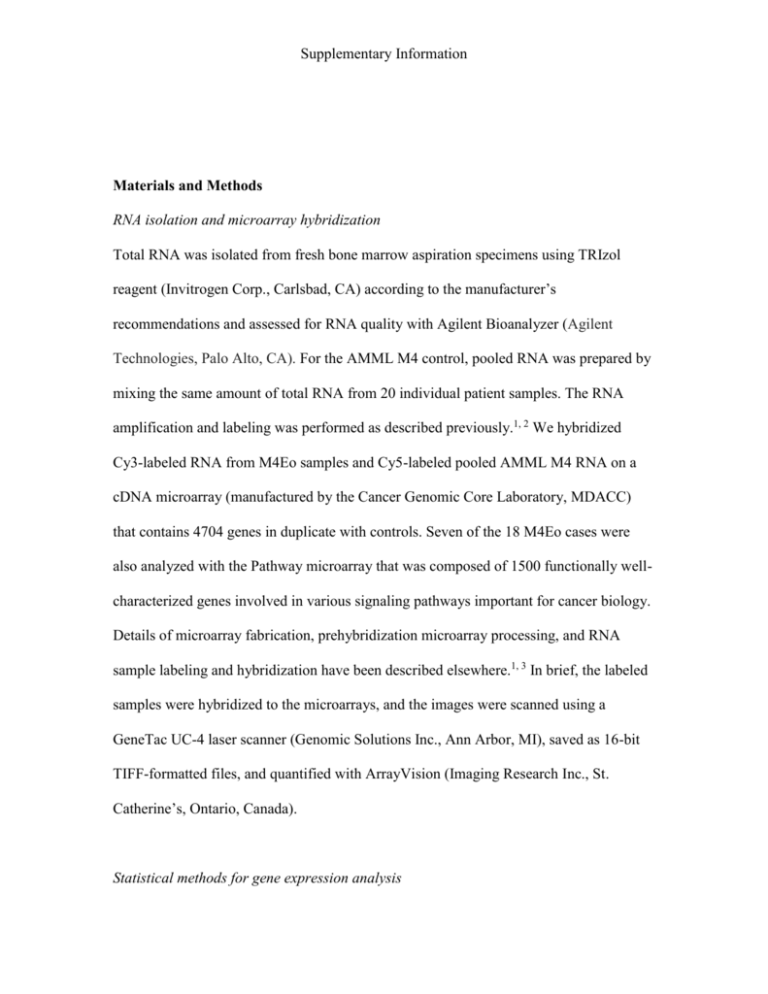
Supplementary Information Materials and Methods RNA isolation and microarray hybridization Total RNA was isolated from fresh bone marrow aspiration specimens using TRIzol reagent (Invitrogen Corp., Carlsbad, CA) according to the manufacturer’s recommendations and assessed for RNA quality with Agilent Bioanalyzer (Agilent Technologies, Palo Alto, CA). For the AMML M4 control, pooled RNA was prepared by mixing the same amount of total RNA from 20 individual patient samples. The RNA amplification and labeling was performed as described previously.1, 2 We hybridized Cy3-labeled RNA from M4Eo samples and Cy5-labeled pooled AMML M4 RNA on a cDNA microarray (manufactured by the Cancer Genomic Core Laboratory, MDACC) that contains 4704 genes in duplicate with controls. Seven of the 18 M4Eo cases were also analyzed with the Pathway microarray that was composed of 1500 functionally wellcharacterized genes involved in various signaling pathways important for cancer biology. Details of microarray fabrication, prehybridization microarray processing, and RNA sample labeling and hybridization have been described elsewhere.1, 3 In brief, the labeled samples were hybridized to the microarrays, and the images were scanned using a GeneTac UC-4 laser scanner (Genomic Solutions Inc., Ann Arbor, MI), saved as 16-bit TIFF-formatted files, and quantified with ArrayVision (Imaging Research Inc., St. Catherine’s, Ontario, Canada). Statistical methods for gene expression analysis Supplementary Information Expression data were analyzed in Splus 6.2 (Insightful, Seattle, WA) and Gene Spring 5.1 (Silicon Genetics, Redwood City, CA) for clustering data as described previously1, 4 Measurements with very low values (< 50 background corrected, in linear scale) were thresholded. The expression values were normalized to the 75% percentile of all measurements, and log2 transformed. Since each probe was replicated at least once (i.e., present at least twice on the array), expression values for each probe were averaged (in the log domain) over all spots for each channel. These values were then differenced, for the log-ratio of probe averages. p-values from the T-statistics were then calculated for each probe, and the beta-uniform mixture model 5-8 was used to adjust for multiple testing in order to control the false discovery rate. False discovery rates were set at 0.05 for the Pathways array, and 0.001 for the cDNA array. cDNA array results were also filtered for absolute fold change of ≥ 2. Different false discovery rates are justified as follows: the Pathways array had fewer probes (1824 vs. 5040), there were fewer samples in the Pathways array data set, and also the data were noisier for the Pathways data set, so the false discovery rates were set to control the total number of false discoveries. Analysis of the combination of data sets There are seven samples in common between the two sets of array experiments, and there are 562 distinct genes (by Unigene cluster ID), represented by 784 distinct probes on the Pathways array, and 773 distinct probes on the cDNA array. To assess the correlation of expression levels between the two array platforms, the following method was used. Probes were grouped within each array by Unigene ID using a common Unigene build. Iterating over each Unigene ID common to both arrays, pair-wise correlations between Supplementary Information each probe on the Pathways array to each probe on the cDNA array for the current Unigene ID were calculated. The distribution of these p-values is shown in Supplementary Figure3, and is clearly skewed towards 1, implying that there is a general correlation between expression values across the two array types. To check whether this skew is significant, we used a permutation test based on the probes associated with Unigene IDs common to both arrays. This ensures that the distribution of null-hypothesis p-values would not be distorted by any differences in probe-specific expression levels or the significance of differences within each array. We permutated the Unigene ID probe-group pairings; i.e., rather than matching probe groups between arrays based on the Unigene ID, Unigene ID probe-groups from Pathways arrays were randomly paired with another Unigene ID probe-group from one cDNA array. The Wilcoxon ranksum test was used to compare the original correlations with the correlations from the permutation. This permutation can be repeated multiple times as in a bootstrap in order to assess the variability of the estimate; this was done, and in 10 repetitions, the Z-statistic from the Wilcoxon rank-sum test never fell below 8.5; the p-value of Z=8.5 is below the precision of the statistical package used; consequently, p never varied from 0. Therefore, a more elaborate bootstrap was not deemed necessary9, 10 Real-time RT-PCR Real-time RT-PCR was performed using the ABI 7700 TaqMan system (Applied Biosystems, Foster City, CA) as previously described.11 Five hundred picograms of total RNA were used as a template in a 50-μL one-step RT-PCR reaction with the Assay-on- Supplementary Information Demand system according to the manufacturer’s instructions. The three genes tested were cyclin D2 (CCND2) (Applied Biosystems’ unique identifying number HS00153380_m1), spermidine/spermine acetyltransferase (SAT) (HS00161511_m1), integral membrane protein 2A (ITM2A) (HS00191609_m1). Cyclophilin was used as the control for quantification. Triplet tests were performed for each gene on each sample, including the AMML M4 control. The analyses were performed using the comparative CT (relative quantitation) method as previously described.2 RT-PCR RT-PCR methods used for detection of CBFβMYH11 fusion transcripts at this institution have been described in detail previously.12 Conventional cytogenetics and fluorescence in situ hybridization (FISH) Conventional G-band karyotype analysis was performed on all samples. The cytogenetic findings in some cases were confirmed by FISH using a Vysis CBF inv(16) dual-color break-apart DNA probe (Vysis, Downers Grove, IL). This probe hybridizes to band 16q22 (spectrum red on the centromeric side and spectrum green on the telomeric side of the CBFβ breakpoint). A split signal confirmed the presence of a breakpoint at 16q22, consistent with inv(16)(p13q22). Flow cytometry immunophenotyping Flow cytometry immunophenotypic studies were performed on EDTA-anticoagulated bone marrow aspiration materials as previously described.13 The t-test was performed for Supplementary Information comparison of flow cytometry immunophenotypic data and p ≤ 0.05 was considered to be statistically significant. Immunohistochemistry We performed immunostaining using 5-μm-thick, formalin-fixed, paraffin-embedded tissue sections, heat-induced epitope retrieval, and the Envision Plus system (Dakocytomation, Carpinteria, CA, USA) on an autostainer (Autostainer Plus, Dakocytomation) according to the manufacturer’s recommendations as described previously.14 Single antibody staining. The following monoclonal antibodies were used: CD34 (1:50, BD Biosciences, San Jose, CA), NF-κB p65 antibody, rabbit (polyclonal GTX27970, GeneTex Inc., San Antonio, TX; 1:100), and cyclin D2 (Cell Signaling Technology, Beverly, MA; 1:25). The small lymphocytes and the blood vessels in the sample were used as internal positive controls for cyclin D2 and CD34 expression, respectively. A case of lung carcinoma was used as a positive control for NF-κB p65 staining. Supplementary Information Double staining. The first antibody (NF-κB p65 antibody) was applied as described above. After visualizing p65 NF-κB expression with diaminobenzidine tetrahydrochloride, we rewashed the section in buffer. Double-stain block (Dakocytomation) was applied for 3 min, the sections were incubated for 30 min at 23ºC with the second antibody (CD34 antibody), and then rewashed. The expression of this second antibody was visualized with Fast-Red substrate (Dakocytomation). All sections were then counterstained with hematoxylin. Evaluation of immunohistochemical results. Three observers (XS, LJM, and CBR) without knowledge of the clinical data evaluated the immunohistochemical results. Double staining was used only for the qualitative evaluation of the coexpression pattern. Cell counts were performed only in the single antibody stained tissue sections. To determine the percentage of tumor cells that exhibited positive immunoreactivity we used x 400 magnification. At least 1000 neoplastic cells were counted in each case. The presence of membrane staining for CD34, and nuclear staining for cyclin D2 and NF-κB p65, were scored as positive. 1. Kobayashi T, Yamaguchi M, Kim S et al. Microarray reveals differences in both tumors and vascular specific gene expression in de novo CD5+ and CD5- diffuse large B-cell lymphomas. Cancer Res. 2003;63:60-6. 2. Hao X, Sun B, Hu L et al. Differential gene and protein expression in primary breast malignancies and their lymph node metastases as revealed by combined cDNA microarray and tissue microarray analysis. Cancer. 2004;100:1110-22. Supplementary Information 3. Song SW, Fuller GN, Khan A et al. IIp45, an insulin-like growth factor binding protein 2 (IGFBP-2) binding protein, antagonizes IGFBP-2 stimulation of glioma cell invasion. Proc Natl Acad Sci U S A. 2003;100:13970-5. 4. Baggerly KA, Coombes KR, Hess KR, Stivers DN, Abruzzo LV, Zhang W. Identifying differentially expressed genes in cDNA microarray experiments. J Comput Biol. 2001;8:639-59. 5. Pounds S, Cheng C. Improving false discovery rate estimation. Bioinformatics. 2004;20:1737-45. 6. Pounds S, Morris SW. Estimating the occurrence of false positives and false negatives in microarray studies by approximating and partitioning the empirical distribution of p-values. Bioinformatics. 2003;19:1236-42. 7. Liao JG, Lin Y, Selvanayagam ZE, Shih WJ. A mixture model for estimating the local false discovery rate in DNA microarray analysis. Bioinformatics. 2004;20:2694701. 8. Reiner A, Yekutieli D, Benjamini Y. Identifying differentially expressed genes using false discovery rate controlling procedures. Bioinformatics. 2003;19:368-75. 9. Dobbin K, Shih JH, Simon R. Statistical design of reverse dye microarrays. Bioinformatics. 2003;19:803-10. 10. Dobbin K, Shih JH, Simon R. Questions and answers on design of dual-label microarrays for identifying differentially expressed genes. J Natl Cancer Inst. 2003;95:1362-9. 11. Rozman M, Navarro JT, Domingo A et al. Morphologic characterization of acute myeloid leukemia with cytogenetic or molecular evidence of t(8;21), t(15;17), inv(16) and 11q23 abnormalities. Haematologica. 2002;87:886-7. 12. Marlton P, Claxton DF, Liu P et al. Molecular characterization of 16p deletions associated with inversion 16 defines the critical fusion for leukemogenesis. Blood. 1995;85:772-9. 13. Sun X, Medeiros LJ, Lu D, Rassidakis GZ, Bueso-Ramos C. Dysplasia and high proliferation rate are common in acute myeloid leukemia with inv(16)(p13q22). Am J Clin Pathol. 2003;120:236-45. Supplementary Information 14. Simons M, Wang M, McBride OW et al. Human nonmuscle myosin heavy chains are encoded by two genes located on different chromosomes. Circ Res. 1991;69:530-9. Figure legends Supplementary Figure 1. Hierarchical cluster of the top differentially expressed genes in the cDNA microarrays. These genes were differentially expressed in at least 9 out of 18 samples with log2 ratio values >|1.5|. Red represents upregulation and green represents downregulation of the genes. Supplementary Figure 2. Expression of cyclin D2 (CCND2), integral membrane protein 2A (ITM2A), and spermidine/spermine N1-acetyltransferase (SAT) genes by real-time RT-PCR. The average fold change of a gene was calculated as expression in M4Eo relative to M4 control. The white bars represent the median value, the lower and upper quartiles are shown by the maroon box and the black bars represent the range. Points beyond the range are outliers. Supplementary Figure 3. Correlation of gene expression levels between the two microarrays. See the text for details.
